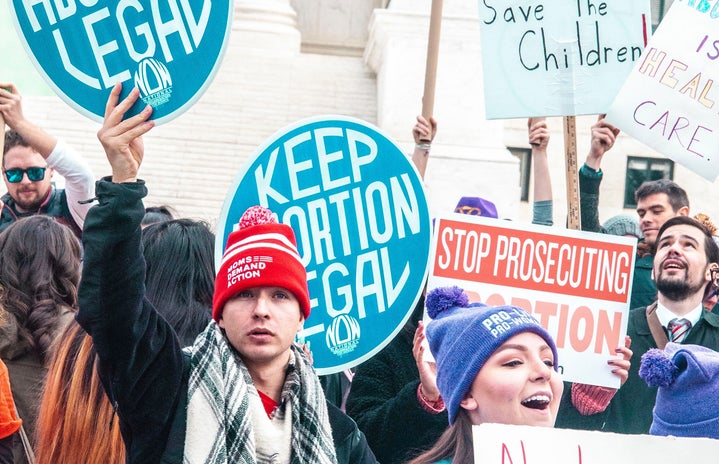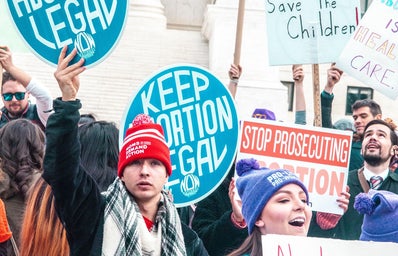Every time election season comes around, there is one issue that never ceases to be a point of conflict. This issue makes the claws come out on both sides of the political scene as people bash one another for not viewing the solution the same way. This issue is abortion. The two sides taken on the topic of abortion are typically ‘pro-life’ and ‘pro-choice.’ ‘Pro-life’ is usually taken up by the right and ‘pro-choice’ is usually taken up by the left.
Often, supporters of ‘pro-choice’ cite wanting women to have bodily autonomy and point out issues of rape, pregnancy complications, and accidental pregnancy for further support. ‘Pro-choice’ voters also tend to have a greater desire to avoid unwanted pregnancies before they happen. ‘Pro-life’ voters, however, cite the idea that a fetus is a life from the time of conception and many ‘pro-life’ voters feel that terminating a pregnancy should be considered murder. Some of these voters swing their ideas in cases of rape and high-risk pregnancies, while others do not. Often, ‘pro-life’ advocates also tout ideas of religious backing for their views and provide Bible verses on murder in order to discredit the notion that ‘pro-choice’ advocates have an appropriate stance on the issue.
No matter where you stand on the issue of abortion, all human beings with opinions will be considered immoral or lacking common sense from the other side. This divide is unhealthy and the singular matter often creates such harsh opposition that this topic alone is enough to elect Republican leaders—even when voters do not support any other Republican policies. It’s safe to say that as a writer, this is an uncomfortable topic to discuss—and perhaps that’s the reason why many people avoid it at all costs. 47% of US voters consider abortion to be a key voting issue and 24% of US voters will not vote for a candidate who does not share their views on the issue. No matter how I tackle this subject, someone is going to be frustrated. That is unavoidable. However, avoiding getting to the root of the issue and only playing the shouting game is old and tiring—it doesn’t accomplish anything and the issue won’t be resolved for either side. That being said, let’s talk about it. I’m not playing the shouting game. I’m not pointing fingers. I’m not here to argue. Let’s get to the point, what both sides want, popular misconceptions, and ways to move forward.
First, Let’s Discuss What Pro-Life Actually Is
The claim ‘Pro-Life,’ as earlier explained, states the idea that a fetus is a life from the time of conception and many ‘pro-life’ voters feel that terminating a pregnancy should be considered murder. However, ‘pro-life’ voters are notoriously known for no longer supporting a fetus after birth. Many who stand in opposition to ‘pro-life’ voters cite the fact that advocates who claim the stance ‘pro-life’ often stand against social programs which help: single mothers, affordable childcare, affordable education and affordable and accessible birth control. These programs are often negatively viewed by those who advocate ‘pro-life’ because they fear an increase in taxes to make it happen. Along with this, many against ‘pro-life’ argue that its supporters do not care about social justice for many racial groups, minority religions, or the LGBTQ+ community—often due to religious explanations, as well. Due to this, many people unfairly die from disparities that continue not to be resolved when leaders who are ‘pro-life’ advocates take office.
For example, the mishandling of COVID under a ‘pro-life’ presidency allowed the USA to be one of the top death rates per capita in the world. ‘Pro-lifers’ who claim a strong connection with the value of human life are often those who refuse to wear a mask which the CDC cites as one of the ways to save lives during the pandemic. ‘Pro-lifers’ also do not always support the Black Lives Matter movement, which is a reaction to many unjust black deaths and criminal punishments. ‘Pro-life’ has the goal of protecting life but does only protecting lives in the womb count? Even if you want to ignore the other loss of life by such leadership, let’s look into how to really reduce abortions and therefore allow more pregnancies to be carried to term.
Why Did Abortion Ever Become A Partisan Issue?
Abortion should reasonably be a time where Democrats and Republicans come together. People may differ on why abortion is an important issue for them but no matter the reason, no one wants abortions to increase and even ‘pro-choice’ is not synonomous for pro-abortion. The major issue is that the two parties see abortion as stemming from different causes. Republican rhetoric often lends itself to stating that having an abortion is a sign of lacking moral character. Democratic rhetoric often lends itself to stating that having an abortion is indicative of larger structural and societal issues that can be solved. However, both parties want this issue to be resolved. This being said, shouldn’t they be able to work together and use the proven methods to lessen the rates of abortion consistently? One would think so.
Abortion began being such a polarized debate when the Republican Richard Nixon decided to use abortion as a strategy of appealing to social conservatives and Catholics. Prior to Nixon, is was normal for Democrats to vote either way on abortion and same with Republicans. However, after Richard Nixon won the election and a majority of Catholic votes, other Republicans copied his tactic to get seats in Congress. This method was successful in helping Republicans win and they continued to strategize with it. The adoption of this tactic can be seen in Republicans like Ronald Reagan. Even though in 1967 as a Californian Senator, Reagan signed a law loosening abortion restrictions, during his Presidential campaign in 1980, he called for anti-abortion judge appointments. This shows the way this issue evolved into being a key way to pull certain voters.
This use of abortion as a political tool for gaining Catholics and social conservatives has continued to be effective, despite the fact that the Republican party does not often support the things which actually lower rates of abortion. This can be seen when looking at what generally helps abortion rates fall but can be distinctly seen when comparing the rates of abortions in different states as they rise and fall along with policies and programs. For the most part, it is often true that it is more ‘pro-life’ to vote ‘pro-choice’ than it is to vote ‘pro-life.’
What Reduces Abortion Rates and How to be Pro-Life for the Baby in the Womb
The Guttmacher Institute developed a study on the differences in abortion rates throughout different regions. The 2017 study pulled together latest research on abortion safety, legality, and unintended pregnancy. It found that abortions have declined over the past 25 years. Many of the falling rates are thanks to improved contraceptive use which reduces unintended pregnancies. However, an important point to note found in this study is that abortion rates are similar in countries where it is highly restricted and broadly legal. The study determined legal restrictions do not eliminate abortion, but only increase the likelihood that abortions will be performed unsafely.
Although the reason why abortions have dropped overall is not completely clear and cannot be reduced to one specific reason, there are a few obvious answers about what is contributing to the declining numbers. The majority of abortions in the United States are due to unplanned pregnancy. Unplanned pregnancies have been decreasing as more women have been using more effective forms of contraception, which are likely linked. Another driving factor may be sex education as the amount of unplanned teenage pregnancies has dropped tremendously. Others who aim to reduce the number of abortions promote: affordable healthcare, free/accessible birth control, sex education, affordable housing, and affordable childcare. One of the most common reasons women have abortions is because they cannot afford to take care of a child. These social programs are thought to help reduce unplanned pregnancies as well as help women who become pregnant and need healthcare, childcare, or housing in order to keep the baby.
In addition to this study, looking at abortion increases and declines by state while looking at the abortion policies/programs they promote, one can see what the best practices are to reduce abortion. When looking at Colorado, for example, there were no majorly-restrictive abortion laws passed for a period of five years. However, free or low cost long-term contraception was given out at 68 planning centers, and there was a 42% decrease in teen abortions and a 10% overall decrease in abortions. Meanwhile, Hawaii, which has also not enacted any new abortion restrictions, tried introducing comprehensive sex education. From this step, their abortion rate fell by 30% in just four years. The impacts of these states which work towards unplanned pregnancy prevention can be seen as very effective when compared to states with strict abortion laws. Louisiana, for example, has passed some of the most restrictive abortion laws in the country and had no social program to help women prevent unwanted pregnancy. Louisiana saw a 12% increase in abortions.
Looking at states and the ways their abortion rates have been impacted through the policies and programs put into place, it becomes fairly obvious what is and is not working. The tried and true methods of abortion reduction are comprehensive sex education and free or affordable birth control. Although it may seem like the easy or obvious answer to make something illegal in order to make it go away, this simply is not true. Abortions were happening before Roe v. Wade. Abortions are happening in places where they are illegal. And women are less safe in these circumstances and more likely to die as a result.
As I bring this up, I have heard many ‘pro-life’ voters proclaim that women who choose to do this are bringing it upon themselves. However, something in me just cannot understand how this lines up with the ‘pro-life’ mindset. Once again, the fact that ‘pro-life’ voters often vote only for the life of those in the womb and not the well-being of those outside of it is not very comprehensive—but especially not when the ways that ‘pro-life’ voters often think of lessening abortions goes against the facts.
Making abortions more restricted while not offering affordable birth control or comprehensive sex education is not going to reduce abortions. And if it does, it won’t be by much. Meanwhile, women will be having many abortions that are less safe and therefore more likely to die in the process. Let me remind you that ‘pro-life’ should want women to live as well. I urge ‘pro-life’ voters to at least consider this information and wrestle with it going into the election. Republican President and Presidential Candidate Donald Trump has went after both birth control and sex education. Pulling back access to birth control and pushing abstinence-only sex education rather than sex education that’s proven to reduce unwanted pregnancy, facts and history tell us what direction these moves will lead us in. Although the rate of abortions have been declining for dozens of years, these policy changes could lessen the rate of decline in abortions.
Reducing abortions should not be about feeling in control or morally superior for telling people what they can and cannot do. They will do what they want, either way. Abortions will continue to happen but the less safe they become, the more women that will be in danger, too. Vote pro-life by voting for officials that promote sex education and affordable and accessible birth control. Vote pro-life by voting for officials that will continue to implement and fund social programs that help single women afford to have children. Be pro-life by helping single and teenage mothers in your area: offer to babysit for free, buy toys and clothes for their children, help them afford food, throw them a baby shower or be emotional support. Be pro-life by fostering or adopting. Be pro-life by pushing for better foster care and adoption systems and getting involved. There are so many effective and commendable things to do to promote the pro-life cause and reduce abortion. But none of those things include a ban.


